After waiting for months. it was time for Pacific Coast Origami Convention a.k.a PCOC, which apparently is read like "peacock". It is a regional conference held every two years. This year's host was San Francisco, on 26th-30th October 2023. I live just 1 hour train ride there, so it was a perfect opportunity to get a taste of an origami convention.
The special guests are Robert Lang and Tomoko Fuse. I am obviously a fan of Lang, but I haven't done any origami related to Fuse. Though I know that she has done a lot of respectable stuff.
Pre-Convention
I set several goals before attending:
- Participate in exhibition
- Teach a class
- Get Lang's autograph on my copy of Origami Design Secrets
- Hangout with origami people as much as possible
- Participate in design challenge
Once registration opened, we could sign up to set up exhibition and teach a class. I signed up to teach my halibut which should be doable within 2 hours.
I contemplated whether or not to stay at Parc 55 hotel (the convention's venue). The price per night after discount was $199, and there were some taxes and whatever bullshit junk fees hotel loved so much, which ended up costing around $230 per night. If I can share the room with someone else, the cost would be halved. That doesn't sound bad compared to 4 hours commuting every day (back and forth, bus+tram+train), or driving to SF and pay the parking fee and be all-day anxious whether the car would get vandalized. I asked if anyone wanted to share a room in Origami-Dan discord, but in the end no one was seriously interested.
I decided to pay the full fare for 3 nights. The base price of $199/night is still cheaper than the hotel venue in New York OUSA convention. Besides, I don't need to spend money to fly. Final reason, this is my first convention, and I don't know what to expect. It is better to just go all out while it is relatively cheaper and use the learning for future convention.
Preparing for Exhibition
Anyone can apply for exhibition. I booked a half table, about the size of 50 cm square. Models are better be shown upright, so I bought some figure stand that Boice recommended. I also printed the little information for each models, consisting of name, version, designer, folder, and crease pattern. The models would be carried in a shoebox to prevent deformation.
 |
| Totally copied Riku Ikuno's presentation style |
Teaching a Class
Truthfully my halibut was designed for conference class. That is why it is not too complex, and has some nice folding sequences. For several weeks, I spend the night folding it and improving the folding sequence, while also practicing the narration. Occasionally I would practice folding in the air. Finally I prepared some contingency plans in case the model couldn't be finished on time, e.g simplifying the shaping
We were instructed to send the model menu to the committee before the convention, either by Thursday 26th November, or mail it to Paper Tree in SF. It was my first time to hear the term "model menu", which is the model to be showcased as preview for classes. For those who don't know, Paper Tree is a paper shop in Japantown SF founded by the Mihara family since 1967. They sell papers suitable complex origami, and various book by Lang, Montroll, or Origami House.
There was no point in me visiting SF just to drop my model menu on Thursday as there weren't any convention activity that day, so mailed my halibut. Fortunately, halibut is a flat fish, so it can be flattened and sent via normal envelope. To anticipate in case the delivery got messed up or lost, I sent my first final fold whose coloration is poorer compare to the second final fold. I would hot swap it with the better fold once I arrived in SF.
 |
| Flatfish to be shipped |
Design Challenge
There was a design challenge with the theme "San Francisco Landmark", so one could design the famous Golden Gate Bridge or Transamerica pyramid (a.k.a the pointy building). They also allow fauna or cultural symbol in SF. I tried to design a Golden Gate Bridge that is not boxpleated, so it has triangular features to represent the cables. However I couldn't figure out the negative space in the middle of the bridge without creating really thick section. In the end I opted for simpler subject, a sourdough bread. It is made from blintzed base to expose the color changed bread slit, and shaped to 3D with rounded crimps. I didn't have time for the fold with better paper as my work got crazy on the last week before convention.
 |
| Sourdough bread. Tastes sour, great on savory sandwiches |
Day 1: Registration and Meeting the Masters
I woke up at 04.45 to brew coffee and have an important meeting with coworker in other part of the world until 05.30. After that I am freed from work and can enjoy the convention to the fullest. So I had big a breakfast, took a dump, and headed out at 06.15 to catch a bus. Taking dump was the utmost importance because I would be in a public transportation for 2 hours straight. That was why I drank coffee, to stimulate the bowel movement.
 |
| Riding tram at 07.00 |
After taking bus, tram, and train, I arrived in Parc 55 at 08.30. On the registration stand, we got our survival kit consisting of T-shirt, convention book, 15 cm kami, writing folding board, and a collapsible plastic box to store folded models. I went straight to exhibition room to set up my stuff, and met a lady in elevator. She was Tomoko Fuse, a very humble and kind person. Then I met Boice in exhibition room and introduced myself. Things were pretty busy back then so we all continue with the set up.
 |
| My exhibition |
 |
| The design contest submissions |
The first class I got is at 10.00, to fold an octagonal star pot by Lang. It was a huge class, about 100 seats and big screen projector. My impression of Lang is he has a very chill college lecturer vibe, who genuinely love the teaching subject. The teaching was smooth, and ended on time. The moment it ended, so many kids and teens go up and wait in line to talk with Lang. Some carries Lang's book and asks for autograph. I joined them, and even though I fear that he would find us annoying, there wasn't any sign of him being annoyed. So the mission to get Lang's autograph and picture was a success.
The next class is at 14.00. I head out to Hinodeya to have ramen lunch, which was close to the hotel. It was delicious, but I had to order extra noodle to satisfy my hunger. I went back to the exhibition room and have a chat with Boice about our models. I learned some techniques he used for his humanoids, like how the Chinese usually structure model's neck, or how to hide seams. I also met Winston and Jared. We did similar thing where we tell stories about our model's creation. It felt nice to finally meet them in person. I do regret not taking pictures of the other's exhibit.
 |
| Boice's Ryujin 3.5 (designed by Satoshi Kamiya). First time seeing one in person, it is tiny! |
 |
| Exhibition room |
I signed up for Jared's sea lion class as 1st choice, but didn't get it. My 2nd choice was Winston's class for a fish curiously called "lookdown". The class spanned for a whooping 2 hours 45 minutes, being the longest class in the whole convention. Indeed it was a difficult model, with tricky collapse and sinks. By far the most difficult class I have ever attended.
 |
| Lookdown fish |
By 17.00, I can finally check in to my room and drop my luggage. There was a reception planned in an hour, so I still have time to hang out around the conference. I visited the paper & book sale by Paper Tree. There were many great books like Works of Fumiaki Kawahata/Yoo Tae Yong/Katsuta Kyohei/etc, and the classics like Lang's Origami Insect and Their Kin. They also sell papers such as tant, Origami-Shop tissue foil (a.k.a Terry foil), thin kraft, and the most interesting one, "nature paper". They are handmade paper with some raw plant elements mixed in, such as flowers, leafs, bark, or even green onion slices. In the checkout desk, there was a stack of Origamido paper. I bought Lang's book, some nature papers, and two sheets of Origamido.
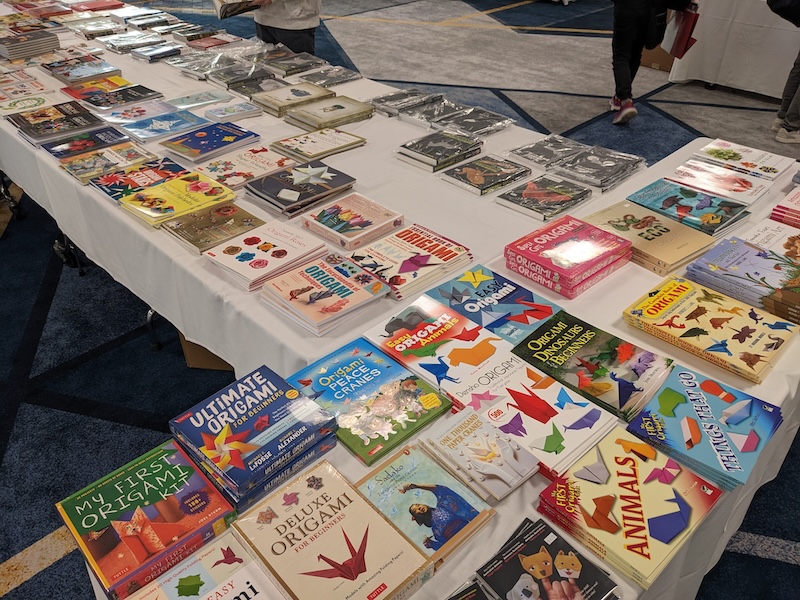 |
| Book sale |
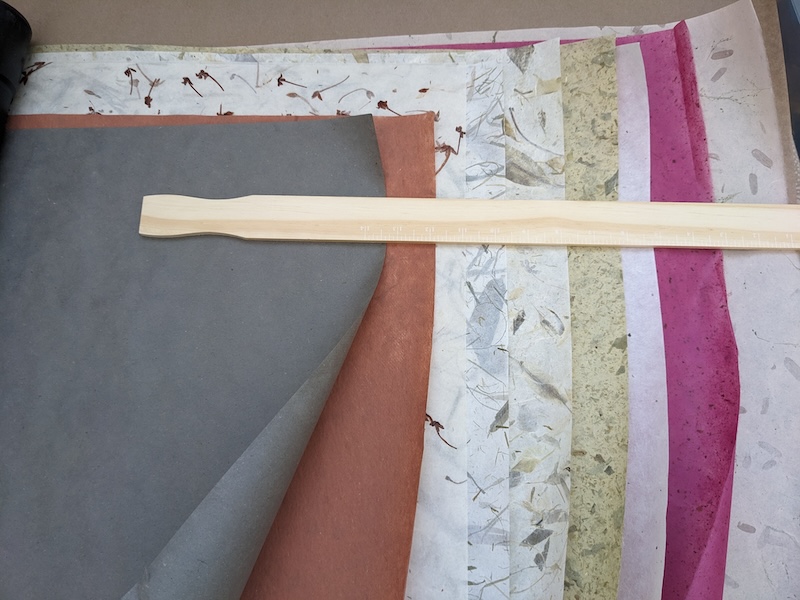 |
| Paper I bought, from top to bottom: origamido (2x), nature papers (ixora, bamboo, eucalyptus, citrus), chiri mulberry (2x), and monet garden nature paper |
While waiting for reception, I went to the community folding room. There was a model menu along the building's desk near its window, and I don't see my halibut in there. I just put my 2nd final fold of the halibut and will ask the committee later about the halibut I mailed them.
 |
| Community folding room, place for hangout |
I spent the remaining time by hanging out with other folder. I met Albert and other UC Berkeley students whom I met back in East Bay Origami Conference earlier this year. The reception itself was pretty frugal. There was a buffet with tiny plates, probably just 15 cm square. Just picking up 3 table spoons of rice and some meats/vegetables already made the plate overflowing.
The reception continues with "chocogami". We will be given a milk chocolate bar from Colombia, whose wrapper consists of a foil backed paper, an oil paper, and a random image in a sticker-like paper. Then we were asked to open the wrapper carefully, eat the chocolate (which is extremely sweet), and use the wrapping papers to fold whatever shown in the sticker within 30 minutes. There would be a judge, and the 3rd place winner got papers, 2nd place winner got a scarf+paper+book+snacks, and finally the 1st winner got Colombian coffee.
Obviously I participated. The picture in my chocolate was a naked big man statue in front of a building.
The wrapping papers are rectangular. I used the foil backed paper for the statue, and the oil-paper for the pedestal.
 |
| My submission |
The plan for humanoid model was quite straightforward. I can use the usual structure to make two forked flap to create legs, and the tiny flap would become the dude's "hardware". The remaining paper is used for hands and head.
We submitted the product in a table. I had to carefully place this model so it stood. Somehow my competitive spirit got ignited and I really want to win. So I sit somewhere nearby to that table, gawking at my model to make sure it was still standing until the end of judgement. I saw some cool models who might be winning, so I don't have high hope.
To my surprise I won the 2nd place. Totally unexpected but of course I was happy. The book seems to be a convention book from Bogota, with Fernando Chura's rabbit as the "star model". The snacks turned out to be some kind of cookies and a dozen of the chocolates again. There is no way I would eat all of that extremely sweet chocolates, but I am still grateful.
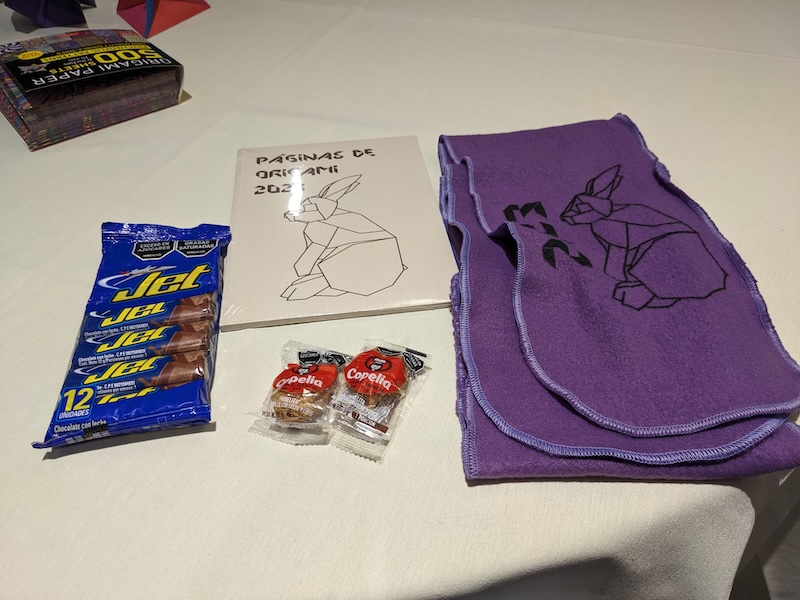 |
| The prizes. The chocolate actually admit that it itself is extremely sweet, you can see there is "exceso en azucares" (excessive in sugar) in the packaging. |
 |
| The chocogami submissions |
I went back to my room to drop some cargos, and head back to community room to ask about what happened to my mailed halibut. The committee wasn't aware of it, and will search it in the actual Paper Tree shop. Well fortunately I have been prepared for this scenario. If it was lost, I am totally fine with it.
The remaining time of that day was spent in community room. I had a chat with Steve, Boice, and taught my sourdough model to others. Some of us will teach in the next days, so we kind of doing a dry run.
I have been awake for more than 18 hours, and my teaching is 10 in the morning. So I head back to my room, ate a Cliff bar (the tiny dinner wasn't enough), took a shower, made a breakfast plan, and slept.
Day 2: Teaching Class and Origami Halloween Banquet
I woke up at 07.50, immediately get dressed and went out to get breakfast. By 08.45, I am ready for 2nd day of convention. The first thing I did was to survey my class room. Will there be projector? Unfortunately, no. Fortunately I have been prepared for this scenario, so I brought a 50 cm square paper, yellow on one side and white on the others. Hopefully it is visible from the back. I also prepared some example model for the final result of a certain hard step. There is one such step, and despite my attempts, I couldn't simplify that fold. Without screen projector it would be hard to show everyone the desired state, so hopefully a physical sample fold would help. I made one sample for every 3 people out of a 15 cm kami.
 |
| Preparing for class |
The class started at 10.00 sharp. It went smoothly as rehearsed. The participants were very good! They easily perform reverse fold, swivel fold, open sink, closed sink, etc. When the fold gets small, I have to walk around and show each table the detailed steps, and verify if they performed it correctly. Some people who were late was somehow able to catch up, thanks to their people sitting next to them. I am amazed that they still remember the first ~25 folding steps.
We spent around 1 hour 15 minutes to finish the body and head. Only 30 minutes left for the tail, and that would be pretty tight. I sped up the pace and the class ended with just 2 minutes left. Everyone succeeded in finishing the model and I was very satisfied. Some of them complimented that my teaching was clear and the pace was great. That meant a lot to me, and I am glad that my rehearsals paid off.
I think the key to a successful teaching is narration. My narration is based on how Jason Ku did it back in FoldFest 2021, when he narrated Yoo Tae Yong's dragon class. He would say something like "valley fold the bottom corner to the crease we made just now" or "make a perpendicular fold originating from the left corner, up to the top right edge; you can do this by aligning the top part edge-to-edge". He would never say "fold this to this", which I greatly resent if any teacher said that. Every time "this" is mentioned, the student has to look at the teacher's fold, match it with theirs, and look at the teacher again to see what would be done. It is easy to lose grasp of what was done, especially if the student's and teacher's model orientation is slightly different.
After having chimichanga as lunch, I proceed to go to the hangout area. Some kids who didn't get my class asked if I could teach them the halibut, so I did. Some of them were very well behaved, but the other behaved poorly. For example, disrupting the flow of teaching by talking about unrelated stuff, or ran away to talk to other friend. They can't sit for 5 minutes straight. I was honestly pissed so next time I should state the rules.
The next class was Miguel's prank toy. It is an action model, with interesting structure and mechanism. There were many inexperienced folder so the class went slowly. The following class is crane base rose by Sakoda, taught by Mark DeWolf-Ott. The rose is made from pentagonal preliminary base.
My final class of the day was Lang's Amazon butterfly. Interestingly he gave us printed template to make some folds with somewhat difficult reference. We finished early, so there was more time to hangout. I learned from Jared that there was Lang's exhibition in Paper Tree. I should go there the next day.
 |
| Template to find reference |
The evening event was cocktail and banquet, with Halloween as the theme. We were encouraged to wear origami with that theme so I wore my antler helmet. The banquet exceeded my expectation. It was a 3 course meal, with salad as appetizer, baked half chicken as entrée, and mousse as desert. We had a costume contest after the meal, and there was someone wearing his exhibition (corrugation stuff) who won the first place. The person is Darryl Bedford. You can see his costume on his instagram post.
There was also a raffle. Three names will be called to receive gift. To yet another surprise, I won the second prize, with Tomoko Fuse's book a price. To be honest I don't fold her stuff, but this would be a start to broaden my horizon. I plan to get her autograph the next day.
The banquet finished around 21.00. I stayed in the community room until midnight, finishing the impromptu halibut class with the kids. Winston Lee came and gifted me a paper he brought from Taiwan. It was an honor to receive his stuff.
Day 3: Tying Up the Loose Ends
I woke up around 7.50, then head down to nearby shop for bread and coffee as breakfast. No time to waste, I went straight to the hangout room. I learned bunch of stuff from Joseph Long, who is experienced in paper preparation. Just before the first class, I saw Fuse in the hall. Finally got her autograph on the book:
The first class in the morning was my first choice of class: Winston Lee's design demonstration. He would design something randomly chosen at the start of the class, which was an angler fish. His design method is something people normally call "free folding". It started with a traditional base with sufficient flaps (usually bird/frog/windmill base) and start creating the basic structure. Detailing like eyes, lips, etc can be handled later. He manipulated each flap to produce another flaps, so point split is essential. Another way to create flap is by sinking sides, and unsink the top.
The design process can focus on a single flap for a single feature, e.g lower jaw. We can isolate and make a test fold for that part with bigger paper. Once a satisfactory result is achieved, integrate it back to the whole model. Otherwise, revise. Record each iteration as crease pattern. Given this iterative nature of design process, it is common to take several iteration until the final fold can be made. For example his lookdown fish model took more than 20 iterations.
One thing I didn't understand is, if his design was made from traditional base then each flap is sequentially manipulated, how come there can be a complicated collapse like what he had on lookdown fish. His answer was during design process, he would find some parts with high stress point; that part can be unfolded and refolded with less stressing layer arrangement. Through that process occasionally another way to collapse that produces better structure can be found. So that is the origin of complex collapse.
The class ended around lunch time. We had Origami-Dan group photo session, then I immediately go to Paper Tree to check Lang's exhibit, and get lunch around there.
 |
| Interior of Paper Tree |
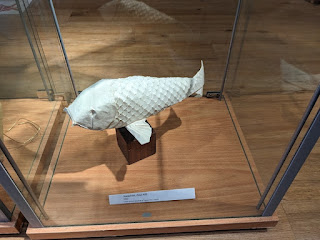 |
| Lang's famous scaled koi being exhibited |
 |
| Lang's "Dancing Crane", it's actually big |
 |
| Ryujin on display |
The afternoon class was John Szinger's single sheet polyhedra. I wasn't very interested in that, and it was my second choice of class. However it turned out to be a very interesting class. Imagine, folding a polyhedra with single sheet of square. Sometimes with color change, dimples, or convexity. Essentially the design tries to form a net for the polyhedra and make them all come together once folded. This class eventually made me buy single sheet polyhedra books by Montroll.
 |
| Notes for single sheet polyhedra |
My final class of the convention was buff crane by Maple Syrup. Arguably the second or third most complex model of the whole convention. The common spread sink, squash, and slide/unsink maneuver to make distributed pleats is used for the crane's six pack. It gets pretty small on 25 cm paper so the class went into chaos where most people went to the front and surround the teacher. There were bunch of annoying teens who didn't pay attention and periodically said "did I miss a step?", or saying "wé' wa'?" (wait what?) every time a step was taught. Even after 2 hours the class wasn't finished. I left early to pick up my exhibition stuff since I remembered a clause that goes like "if your exhibition item was not picked at least by 5 PM, it will become Origami USA's property".
There were still a final event that night: The Amazing Race Origami Syle (a.k.a TAROS). I had formed a team with Bryndon and Thomas whom I just met that day. The game was simple: each team of 3 persons will solve a challenge on a post, then move on the next post. Each challenge solve will grant certain points of reward, and the team with most points won. It was fun, but I was pretty bad at non-figurative origami challenge such as modulars. For real, it was the first time I heard about "Sonobe cube". Luckily Thomas is a well rounded folder who knows bunch of stuff. So I just follow his guide. Here are the 8 challenges:
- Make a paper "banger". Basically a folded paper which produce loud bang if you violently swing it downward. I remember folding these back in elementary school, so it was an easy win.
- One person reads instruction, one person folds, and another person watch. The final model will have some letters aligned and that would be the password to finish the challenge. Quite straightforward and we finished it.
- Use paper straw to move some black papers to form Jack o'lantern's eyes, nose, and mouth. Easy too.
- Fold two wasterbombs, mark it with dots to make dices, and keep throwing until you get the cumulative sum of the numbers between 20 to 23 (because it is 2023). The sum resets if the it exceeds 23. We were fast and I threw the dices numerous times, but unfortunately we never reach the target numbers.
- Given six Sonobe cube modules, assemble it while wearing snow gloves. I had no idea what Sonobe cube is, but Thomas knew. So we successfully assembled it following his instruction
- Given 3 sets of Colombus cube modules and assembly instruction, produce 3 Colombus cube sand stack then together. Again, no idea what Colombus cube is. The instruction was flipped over so we have to mirror it on our head. Pretty difficult to do on 3D model assembly but I was able to do it with few seconds left.
- One person pick a random animal model from a bag, one person make a gesture without speaking, and one person has to guess what it is. Once done, rotate the roles. Basically a charades. We were only able to guess 4 correctly.
- Given 4 folded models, and 5 crease patterns. Pair the models with their corresponding crease patterns. We were the only team who was able to pair all 4 models correctly.
Anyway despite our best efforts, we got the 4th place. The winning team has the most diverse team knowledge.
By this time many participant had left the convention to catch their airplanes. Only about 25% participants left. On the final hanging out night, a pile of unsold items are dumped on a table and we're free to pick anything. I got this nicely small sized OUSA 2010 convention T-shirt. I can wear it on future convention to pretend as convention OG.
I have to catch an early morning train tomorrow, so I went back to hotel room for packing and good night rest. There was a post convention tour around San Francisco tomorrow, but I will skip it.
Post Conference
Having fully experienced the convention, I can say that it was a great one. Meeting the masters, interacting with friends, looking into exhibition items in person, and broadening horizon was the highlight. I will surely attend the OUSA convention 2024 in New York, at least that one time.
Key Takeaways
- The best part of convention is not necessarily the class or exhibition. It is actually the late night folding & hangout with friends. So for future conference, I will be sure to pick lodging that allows going home at midnight safely.
- Many participant will leave in the night of convention's last day. So it might not worth another night of lodging.
- Food may be scarce. The event's food can be not filling enough, and hotel's food is expensive. Since we are likely to stay until midnight in a cold room, hunger will creep in. It is best to have midnight snack prepared. Something not too sweet or salty.
- If you're designer, prepare some models you can teach in an impromptu class. It is fun to take turns teaching something during hangout session.
- Bring bone folder or any pointy tool that you normally use. It is also helpful to show how steps are done to someone sitting beside you if they ask for help. I prefer to use pointy tool than my big finger.
- Take pictures often!





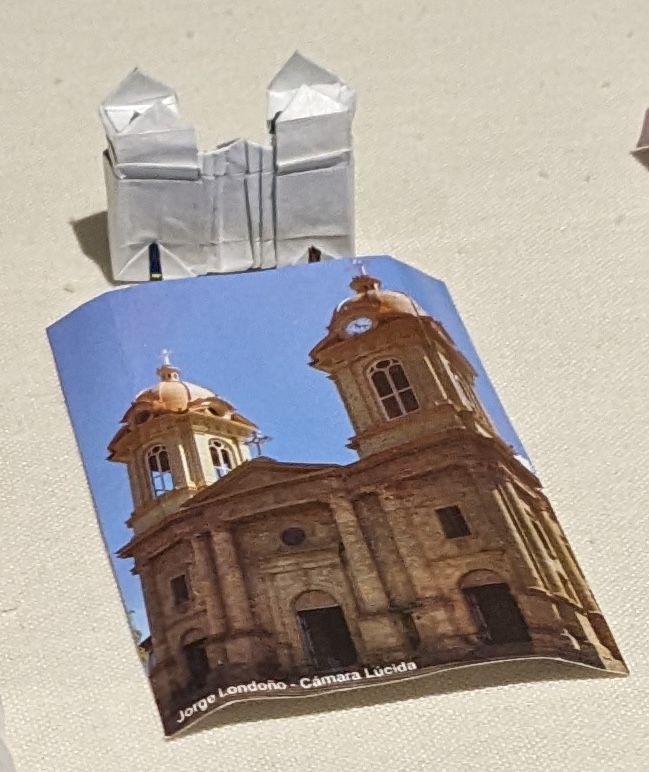

Comments
Post a Comment